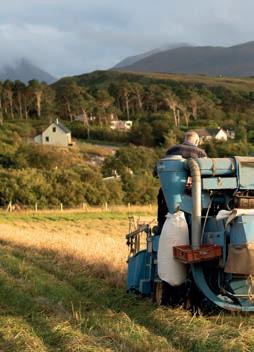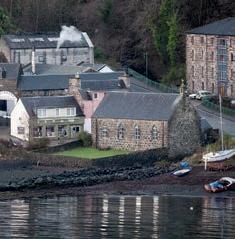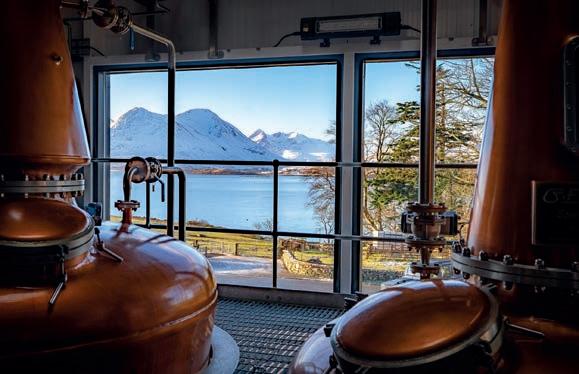
4 minute read
Whisky
SMOKE SIGNALS
For many, peat-fire smokiness is the definitive flavour of island whisky. However, Jason Thomson finds that the story of distilling on various islands reveals some surprisingly divergent styles

There is a prevailing idea of what Scotland’s islands are – and then there is the reality. In fact, the Scottish islands might be among the most misunderstood archipelagos in the world. This isn’t to say the islands aren’t beautiful. They are. On the right day, their views and vistas are breathtaking. However, the Scottish islands painted in the minds of people through their memories of Whisky Galore are far from the truth. In fact, they do a disservice to the people that live there, and even to group them all as 'islanders' doesn’t ring true. Each island presents its own challenges. Living on Orkney is not like living on Mull, and life on Eigg has its differences to life on Skye. Each island is its own and, in some ways, that helps shape the people that live there.
This carries over to the whiskies made on the islands. They each have their own particular style, often shaped by their particular island. There is no common flavour or technique – instead, like the people, they each have their unique way of doing things, with some islands even being home to several styles.
Mull, for example, has been home to the Tobermory distillery (in some shape or form) since 1798, making it one of the oldest commercial distilleries in Scotland. Over the years, distillers have had different thoughts on what a whisky from Mull might be, and this has led Tobermory to have not one, but two distinct single malts being produced at the same distillery. The whisky named Tobermory is light, fruity and holds a hint of spice. The other, Ledaig, is most recognisable for its sweet smoke and earthy character. The only difference between the two whiskies is the use of peat to dry the barley at the start of the process, but this singular change makes for two very different drams.
The Isle of Arran is in a similar situation. When the distillery first opened in 1995, it was producing both a fruity, Speyside-style malt and a much heavier, peated spirit. The global demand for single malt whisky has exploded in the ensuing years and Arran, like many distilleries, has had to grow. Instead of splitting the time of one distillery to make two styles, they built a new distillery (The Lagg distillery) to make their peated whisky. One island, one company, but two distilleries making two very distinct whiskies.

Clockwise: Tobermory; Isle of Raasay; Bruichladdich; harvesting barley on Raasay

Arran isn’t the only whisky isle that’s seen innovation though. On the Isle of Raasay, the island’s first ever distillery hasn’t only been experimenting with its spirits, it has been holding trials for its ingredients. Raasay’s team has been working to bring barley back to the island, with the first crop in 40 years being grown in 2017. It’s hoped the trials will find a barley that can be used to make single malt at the distillery, helping it further its own unique style.
If any island is thought to have its own ubiquitous style it is – without doubt – Islay. The whiskies from Islay are thought to be big, bold and dripping with smoky intensity. This is especially true of the south coast of the island, home to Laphroaig, Lagavulin and Ardbeg, the trinity of big Islay smoke. But even on Islay there are outliers. On the northern shore lies Bunnahabhain, which bucks the norms of Islay and forgoes the use of peat in its core range. Their whisky is better known for its rich, smooth and nutty texture.
Bunnahabhain isn’t alone in shunning smoke. Re-opened in 2001, Bruichladdich has a very different idea of what a whisky bearing the Islay name could be. It was about the place and the provenance more than about the peat and the smoke. On opening, the signature Bruichladdich style was sweet, honeyed and citric, a huge counterpoint to most drams made on the island. The ethos of the distillery is one of experimentation, with many unusual wine casks being used in the maturation of its more limitededition expressions. As the years have passed, a more traditional peated selection known as the Port Charlotte has been added to the ranks, but the Bruichladdich ethos still holds firm. Bruichladdich, in a similar vein to Raasay, work closely with local farms to grow barley for its whisky. This symbiotic approach has yielded terrific results – helping local farmers and allowing Bruichladdich to become a vital part of the island itself.
This is true for almost all the distilleries on Scotland’s islands. Distilleries are essential cogs in the everyday workings of the community, and the whisky they make is shaped just as much by their island home as the people that live there. To think otherwise would be to do them a disservice.












